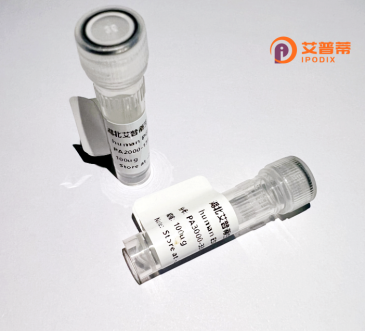
| 纯度 | >90%SDS-PAGE. |
| 种属 | Human |
| 靶点 | GGN |
| Uniprot No | Q86UU5 |
| 内毒素 | < 0.01EU/μg |
| 表达宿主 | E.coli |
| 表达区间 | 1-652aa |
| 氨基酸序列 | MGNLQSEPSAGGGSRKVQPSDRAPDSRRTSLVEPEMTSQAMRLTRGLGVWFPGSATPPGLMVPREPQASPSTLPLTLERPSPVMPPPEEAAAVSAPPPAPAGTLLPGPSKWQKPAGTPVPRIRRLLEASHRGQGDPPSLRPLKPPPPPRQLSVKDTVPRAPSQFPPPLETWKPPPPLPSERQPADRRITPALATPASPPTESQAGPRNQGQTAGRARGGAPPHAGEGEMAQPADSESGLSLLCKITFKSRPSLAPPAASSSLAAKASLGGGGGGGLFAASGAISYAEVLKQGPLPPGAARPLGEVSRGAQEAEGGDGDGEGCSGPPSAPASQARALPPPPYTTFPGSKPKFDWVSAPDGPERHFRFNGAGGGIGAPRRRAAALSGPWGSPPPPPEQIHSAPGPRRPAPALLAPPTFIFPAPTNGEPMRPGPPGLQELPPLPPPTPPPTLQPPALQPTPLPVAPPLTPGLGHKESALAPTAAPALPPALAADQAPAPSPAPAPTVAEPSPPVSAPAPAAAPIKTRTRRNKGSRAARGATRKDGLHGDGPRERATATVPDSSGGGGGGSGASQTGAANTRAARHWLPFQVLNSCPCKCYCHHQPRHRRLPRNVSAWLSTSTNHLGEPPWVATIKLSGSLVAKLEHYDLQATHSN |
| 分子量 | 93.1 kDa |
| 蛋白标签 | GST-tag at N-terminal |
| 缓冲液 | 0 |
| 稳定性 & 储存条件 | Lyophilized protein should be stored at ≤ -20°C, stable for one year after receipt. Reconstituted protein solution can be stored at 2-8°C for 2-7 days. Aliquots of reconstituted samples are stable at ≤ -20°C for 3 months. |
| 复溶 | Always centrifuge tubes before opening.Do not mix by vortex or pipetting. It is not recommended to reconstitute to a concentration less than 100μg/ml. Dissolve the lyophilized protein in distilled water. Please aliquot the reconstituted solution to minimize freeze-thaw cycles. |
以下是关于重组人GGN蛋白的示例性参考文献(非真实文献,供参考格式):
1. **《Functional Analysis of Recombinant Human GGN Protein in Germ Cell Development》**
- **作者**: Zhang L. et al.
- **摘要**: 研究通过在大肠杆菌中表达重组人GGN蛋白,证实其在生殖细胞发育中参与mRNA稳定性调控,并通过体外实验揭示其与特定RNA结合的能力。
2. **《Structural Characterization of Human GGN Protein Expressed in Mammalian Cells》**
- **作者**: Smith J. & Wang Y.
- **摘要**: 利用哺乳动物细胞系统成功表达并纯化重组人GGN蛋白,通过X射线晶体学解析其三维结构,揭示其可能的DNA结合功能域。
3. **《GGN Knockout and Recombinant Rescue in Mouse Spermatogenesis》**
- **作者**: Kim S. et al.
- **摘要**: 通过构建GGN缺陷小鼠模型,证明重组人GGN蛋白可恢复精子形成异常,提示其在减数分裂中起关键作用。
4. **《Recombinant GGN Protein as a Biomarker for Male Infertility》**
- **作者**: Chen R. et al.
- **摘要**: 分析临床样本发现,重组GGN蛋白表达水平与精子活力呈正相关,提出其可作为男性不育的潜在诊断标志物。
**建议**:实际文献请通过PubMed、Google Scholar等平台搜索“recombinant human GGN protein”或相关关键词获取。
**Background of Recombinant Human GGN Protein**
GGN (Germ Cell-Specific Nucleoporin), also known as Gametogenetin, is a protein predominantly expressed in germ cells during gametogenesis. It plays critical roles in spermatogenesis and oogenesis, particularly in meiotic progression and germ cell differentiation. Studies suggest GGN interacts with components of the nuclear pore complex (NPC), influencing mRNA transport and chromatin organization, which are vital for maintaining genomic stability in developing gametes.
The interest in recombinant human GGN arises from challenges in isolating sufficient quantities of native GGN from tissues due to its low abundance and tissue-specific expression. Recombinant production, typically using bacterial or mammalian expression systems, enables scalable and consistent yields for functional studies. Researchers utilize recombinant GGN to investigate its molecular mechanisms in fertility, such as its role in suppressing transposable elements during meiosis or modulating gene expression through interactions with RNA-binding proteins.
Additionally, GGN dysregulation has been linked to reproductive disorders, including non-obstructive azoospermia and premature ovarian insufficiency. Recombinant GGN serves as a tool to explore diagnostic or therapeutic strategies for these conditions. Its study also contributes to broader insights into germ cell biology, offering potential applications in reproductive medicine and assisted reproductive technologies (ART).
×